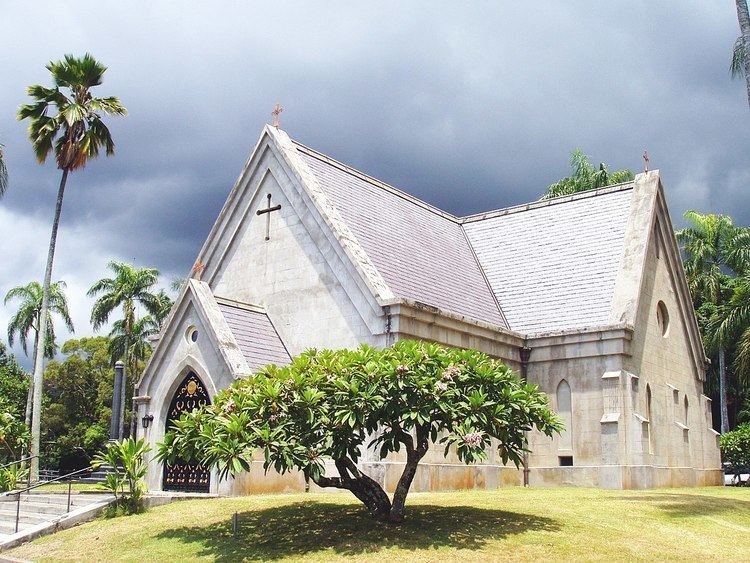Area 4 acres (1.6 ha) Architectural style Gothic Added to NRHP August 7, 1972 | Built 1863 NRHP Reference # 72000422 Opened 1863 | |
 | ||
Location 2261 Nuʻuanu Ave., Honolulu, Hawaii Address 2261 Nuuanu Ave, Honolulu, HI 96817, USA Hours Open today · 8AM–4PMThursday8AM–4PMFriday8AM–4PMSaturdayClosedSunday(Prince Kūhiō Day)ClosedMonday(Prince Kūhiō Day (Observed))8AM–4PMHours might differTuesday8AM–4PMWednesday8AM–4PMSuggest an edit Similar Kawaiahao Church and Missi, Hānaiakamalama, ʻIolani Palace, Nu‘uanu Pali, Washington Place | ||
Royal mausoleum of hawaii
The Royal Mausoleum of Hawaii, known as Mauna ʻAla (Fragrant Hills) in the Hawaiian language, is the final resting place of Hawaii's two prominent royal families: the Kamehameha Dynasty and the Kalākaua Dynasty.
Contents
- Royal mausoleum of hawaii
- Royal mausoleum of hawaii honolulu oahu lookintohawaii com
- Description
- Construction
- Kahu of the Royal Mausoleum
- References
Royal mausoleum of hawaii honolulu oahu lookintohawaii com
Description
The site is located at 2261 Nuʻuanu Avenue in Honolulu, Hawaii on the island of Oahu, coordinates 21°19′30″N 157°50′50″W. The grounds of the mausoleum are surrounded by a black fence, bearing the royal seal of the Kingdom of Hawaii at the gate. A small chapel is located near the center, immediately behind the tomb of Kalākaua and his family, and to the right of the Kamehameha tomb, Bishop Monument, and Wyllie tomb. The chapel, in the shape of a Latin cross, is one of the few examples of Gothic Revival architecture in the islands.
Construction
The 2.7 acre (11,000 m2) mausoleum was designed by architect Theodore Heuck. King Kamehameha IV and Queen Emma planned it as a burial site for their four-year-old son, Prince Albert, who died August 27, 1862. King Kamehameha IV became ill soon afterwards and died November 30, 1863, just 15 months after his son. His brother Lot Kamehameha came to the throne as King Kamehameha V.
Immediately Kamehameha V started construction of the mausoleum building. The Right Reverend Thomas Nettleship Staley, first Anglican Bishop of Honolulu (1823–1898), oversaw construction. The west ('Ewa) wing was completed at the end of January 1864. A large funeral procession February 3, 1864, brought the body of Kamehameha IV from ʻIolani Palace near Kawaiahaʻo Church. His casket was placed on a stand in the new wing. Later in the evening, bearers brought the casket of Ka Haku o Hawai'i (as Prince Albert was known) and laid him to rest alongside his father. Queen Emma was so overcome with grief that she camped on the grounds of Mauna ʻAla, and slept in the mausoleum.
The mausoleum was completed in 1865, adjacent to the public 1844 Oahu Cemetery. The mausoleum seemed a fitting place to bury other past monarchs of the Kingdom of Hawaii and their families. The remains were transferred in a solemn ceremony leading from the burial vault called Pohukaina at ʻIolani Palace to the Nuʻuanu Valley October 30, 1865.
Robert Crichton Wyllie, Minister of Foreign Affairs, was buried here in October 1865. Over time, the remains of almost all of Hawaii's monarchs, their consorts, and various princes and princesses would rest at the Royal Mausoleum. Kamehameha I and William Charles Lunalilo are the only two kings not resting at the mausoleum. William Charles Lunalilo, the shortest-reigning Hawaiian monarch, (one year and 25 days only), was buried in a church cemetery resting in the courtyard of Kawaiahaʻo Church. Princess Nāhiʻenaʻena and Queen Keōpūolani are buried on Maui at Waiola Church.
Kamehameha I's remains were hidden in a traditional practice to preserve the mana (power) of the aliʻi at the time of the Hawaiian religion. For several generations, descendants of Hoʻolulu, one of the few chosen to help bury the remains of Kamehameha, have been appointed as caretakers.
Mauna ʻAla was removed from the public lands of the United States by a joint resolution of Congress in 1900, two years after the Annexation in 1898 of Hawaii Territories by President William McKinley.
The Mausoleum is one of the only places in Hawaii where the flag of Hawaii can officially fly alone without the American flag; the other two places are ʻIolani Palace and the Puʻukoholā Heiau.
June 24, 1910, the caskets from the Kalākaua family were moved to an underground vault excavated from rock.
In 1922 the main building was converted to a chapel, and the royal remains were moved to tombs constructed on the grounds. The chapel was added to the National Register of Historic Places August 7, 1972.
Kahu of the Royal Mausoleum
These are the keepers or kahu of the Royal Mausoleum at Mauna Ala:
